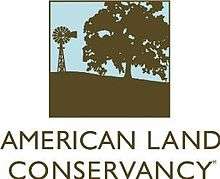American Land Conservancy
The mission of American Land Conservancy is to conserve land for the benefit of people and wildlife.

| Incentive | |
| Industry | Professional Organization |
| Founded | 1990 United States |
| Headquarters | California, United States |
About ALC
American Land Conservancy is a non-profit land conservation organization dedicated to protecting America’s natural heritage by conserving land for the benefit of people and wildlife. Since 1990 ALC has conserved more than 276,000 acres (1,120 km2) of land and water resources, working farms and ranches, and wildlife habitat, nationwide.
Programs
In its first 15 years, ALC pursued projects based on the opportunities at-hand, tackling projects across the country. Their work is now focused on the following regional landscape programs:
- Alaska
- California Central Valley and Foothills
- Great Basin
- Mississippi River
- West Coast Trail
- American Landscapes
Conservation ethic
The organizations 'conservations ethic includes the following principles:
- We seek to foster healthy ecosystems by preserving biological diversity and protecting habitats.
- We believe people need open space to connect to nature and recharge.
- We understand that healthy ecosystems are essential to sustainable economies and communities.
- We believe in conserving working farms and ranches to sustain historic landscapes and a way of life.
- We consider collaboration to be critical to the future of land conservation in America.
- We believe that private landowners can often serve as the best stewards of land.
Conservation services
Direct Purchase – ALC works with landowners who wish to sell or donate their exceptional land for conservation by finding a public agency or conservation buyer to own and manage the land permanently. Funding for acquisition can come from state or federal appropriations, philanthropic foundations or individuals. Sample projects: BK Leach Memorial Conservation Area #MO#, Crow Creek Falls #MT#, High Meadows #NV#.
Conservation Easement – A conservation easement is a legal agreement between a landowner and a land trust or government agency that permanently limits uses of the land in order to protect its conservation values. It allows the landowner to continue to own and use the land and sell it or pass it on to heirs subject to the restrictions of the easement. ALC often works with a conservation partner who holds and monitors the easement. Sample projects include the Hearst Ranch #CA#, (in conjunction with the California Rangeland Trust), Bridgeport Valley #CA#, Kaskaskia Island #IL#.
Acquisition of Surface or Sub-surface Rights - Sometimes the surface of a landscape is protected, but a company or individual owns the assets on top #timber#, or underneath the surface #mining, water, natural gas#. ALC acquires these rights to prevent development and habitat destruction in pivotal landscapes. Sample projects: Bodie State Historic Park #CA#, Denali National Park #AK#, Valles Caldera #NM#.
History
The genesis of American Land Conservancy can be traced to founder Harriet Burgess' first trip down the Grand Canyon. The trip guide was the legendary Martin Litton, founder of Grand Canyon Dories, editor for Sunset Magazine, and as described by David Brower, "conscience of the Sierra Club." Martin inspired her to see the natural world as never before.
Many years and many trips later, Harriet started ALC in order to pursue the protection of another canyon – Topanga Canyon in the Santa Monica Mountains of Southern California. She founded ALC with the contents of a modest retirement fund, and proceeded to option the 1,655-acre (6.70 km2) Topanga Canyon property from the owners—for $1. Ten years later, the project was successfully completed.
Under Harriet, ALC’s mission was to fill a niche in the land preservation movement, taking on projects too large for purchase by local land trusts and too complicated and high-risk for larger, national land trusts. Some of ALC’s signature projects over the years have included the acquisition of tens of thousands of acres for the Humboldt-Toiyabe National Forest in California and Nevada, large-scale wetlands restoration along the Mississippi River, and most recently, conservation of the 82,000-acre (330 km2) Hearst Ranch on the California Central Coast.
Since the beginning, Martin Litton played a vital role as co-founder, connecting Harriet and her cause to such conservation legends as Bruce Babbitt, David Brower, Pete McCloskey, Margaret Owings, Galen Rowell, Wallace Stegner, Stuart Udall, Ardis Walker, and more. By staying the course and never backing down from a challenge, ALC’s small staff was able to conserve hundreds of thousands of acres across fourteen states during Harriet’s era.